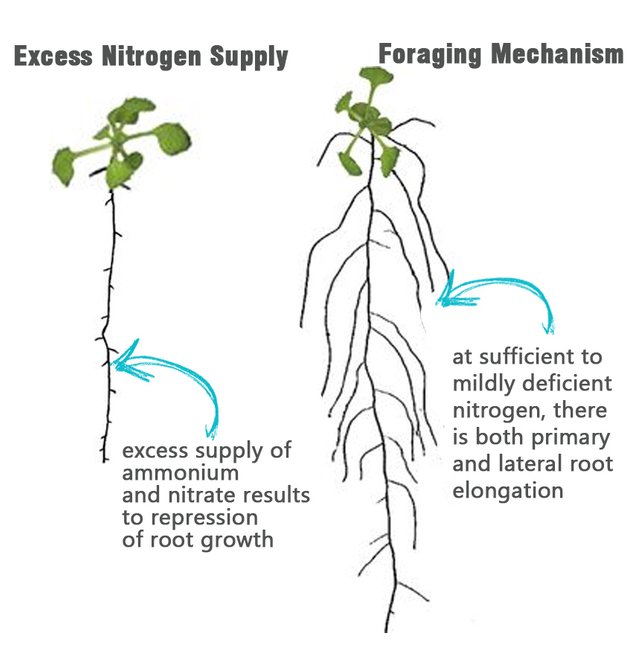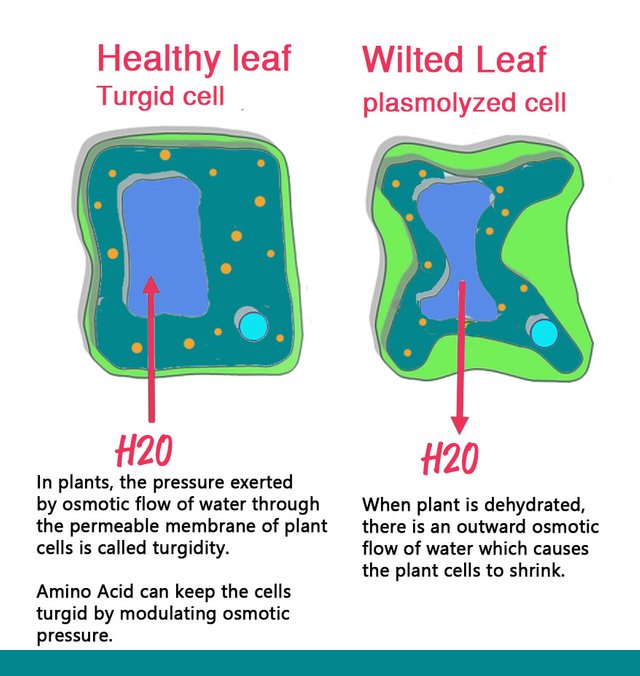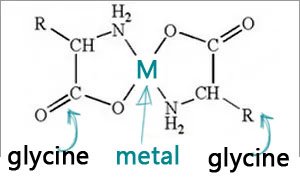Amino Acid Supplements for Plants: How Amino Acids can Affect Plant Growth and Resistance to Environmental Stress
Amino acid supplementation is common to athletes to support their workouts and aid in muscle growth and development. Amino acids are the building blocks of proteins which is what muscles are made of. Besides muscle growth, amino acids are important to support the biological functions of human cells...in fact all living cells. How about plants? They too, consist of living cells, right? Will they benefit from amino acid supplementation?

Well Yes! Amino acid Supplements can be beneficial for plants
Like any other living organisms, plant cells are made up of amino acids. And being the common element found in all types of Amino acids, plants need nitrogen for growth and survival. Studies have confirmed that plants of wide range of species is capable of amino acid uptake.
Well Yes! Amino acid Supplements can be beneficial for plants
Like any other living organisms, plant cells are made up of amino acids. Being the building blocks of proteins, amino acids has structural, metabolic and transport process in plants Amino acids also play a role in biosynthesis of non-protein compounds such as vitamins, coenzymes, pigments, etc. Studies have confirmed that plants of wide range of species is capable of amino acid uptake, including monocots, dicots, and gymnosperms [4,7,8].
But How do they absorb Amino acids?
Amino acid can be absorbed directly by plants through their roots. Plants that have access to amino acids from the soil would no longer have to rely on microbial mineralization to produce Nitrogen from inorganic sources or microbial decomposition to breakdown proteins. This eliminates the bottlenecks of Nitrogen cycle in soils.[6]

There are also strong evidences that plants can absorb amino acids through their leaves, which is introduced through foliar feeding. It occurs through the penetration of amino acids into the plant tissues via diffusion through the membrane pores. [11]
Foliar Feeding/ Foliar Fertilization – is a method of applying liquid fertilizer to plants directly on their leaves. Plants absorb the nutrients through the stomata and leaf epidermis.

Amino Acid Role in Root Development
Plants partition nutrients and energy for growth to adapt to environmental conditions. Nitrogen, an element common in all types of Amino acids, plays an important role in growth distribution. When the plant is supplied with large amounts of Nitrogen, which is usually the case in chemical fertilization, the plants tend to decrease nitrogen uptake. This usually directs growth allocation for shoot growth with consequent decrease in root growth. Plants fed with high levels of nitrogen increase its shoot length but not the lateral length of its roots. Introduction of excess amount of nitrates from chemical fertilizer inhibits the flow of auxins. Auxins are plant hormones responsible for growth and has an essential role in root development. Plants with poor root system will survive if there is abundant supply of water. However, when plants are subjected to stress due to water scarcity, the under developed root system cannot hold enough water to sustain development. This is one of the reason why heavy use of chemical fertilizers decreases the tolerance of crops to drought.

Methionine, a type of amino acid plays an important role in the synthesis of auxins. Application of amino acid can improve elongation of roots and improve nutrient absorption. Cysteine, another type of amino acid, plays a vital role in the development of hairy roots. [13] A study by has shown increase in secondary roots and morphological changes in maize root architecture after application of both plant based and meat-based amino acid from protein hydrolysates [12]. A study by Walch Liu, et. al (2006) has shown convincing evidence that the amino acid L-glutamate can act as an external signaling molecule to trigger changes in the root development by increasing the plant's ability to compete with neighboring plants and resident soil microorganisms for local organic nitrogen in the soil. [6]
When subjected to environmental stress, amino acids can help improve the root system of crops to improve its foraging mechanism. Plants adapt to stress by increased growth of lateral roots to help scavenge heterogeneously distributed nutrients in the soil. [6]
Role of Amino Acids in Osmotic Regulation
Availability of water is a major factor affecting yield of many agricultural crops. Water scarcity limits cell expansion and reduces cell rigidity due to water loss. These cellular effects of water stress is manifested through restricted shoot and leaf growth.[1]

Free amino acids are osmotically active substances that contribute in osmotic pressure adjustments during water scarcity stress, thus keeping the cell wall rigid and keep cells from shrinking due to dehydration. [7] Externally sourced amino acids can help in regulating membrane permeability and ion uptake which is how amino acids mitigate drought or even salt stresses [8]
Amino Acids as Chelating Agent: Enhanced Nutrient Absorption

Besides the Macronutrients like Nitrogen, Potassium and Phosphorus, plants also need Micronutrients like Iron, Calcium, Magnesium, Copper, Zinc and Manganese especially when subjected to environmental stress. Amino acids can act as chelating agents. Chelating agents can form several bonds with metal ions. Chelated nutrients has increased mobility and absorption in plants.
Where Do we Find Sources of Amino Acid Supplements for Plants?
There are several products in the market that claims to contain Amino acids and function as bio-stimulants plants. These mostly contains protein hydrolysates of animal origin. Hydrolyzing proteins through enzymatic reaction is a common method of producing amino acids. Plant proteins can also be used like soy.
Enzymatic Hydrolysis of protein is a process of breaking down proteins into smaller peptides and amino acids by enzymes called proteases.

Most amino acid products are available as concentrated liquids that are meant to be diluted with water and used as foliar fertilizer. An example of an amino acid liquid fertilizer in the market is a product of enzyme hydrolysis from fish. This is produced by addition of enzymes in fish after grinding. Hydrolysis occurs by subjecting the mixture in an optimum pH and temperature for enzymes to work.
Disadvantages of Amino Acids as Supplements for Plants
Understanding the mode of action of agricultural products is very important for effective marketing, consumer information and regulatory requirements. Each type of amino acid may have different effect on different species of plants, in which the mode of action of individual amino acid in a heterogeneous mixture is difficult to identify.
The complication lies on the multiple undefined components of products that contain amino acids due to where it is usually sourced. Because Amino acids are usually sourced from biological process or extraction from biological materials. In most cases, the efficacy of these products cannot be elucidated by the individual characteristics of each amino acid but to the synergy of complex mixture of amino acids and other organic chemicals.
Future of Amino Acids in Agriculture Technology

So what’s in it for Amino Acid as Agricultural input? Amino acid as a Nitrogen Source for plants has potential to improve Agriculture Technology. According to Food and Agriculture Organization (2008), in 2007, there is approximately 128 million tonnes of Chemical Nitrogen fertilizer applied globally. A huge percentage of these fertilizers are not absorbed by plants and the remaining are lost to surface run off, volatilization in the atmosphere and leaching which can pose environmental danger. The concern on fertilizer-caused pollution and the cost of fertilizers in the global market altogether makes a compelling need to develop strategies in agriculture that could lead to satisfactory yield with lesser requirement for chemical fertilizers. Amino acids can be one of economically viable means to minimize chemical fertilizer foot print while maintaining high harvest yields.
Alleviating the negative effect of environmental stress is an important determining factor in the productivity of agricultural plants. Though the mode of action is not yet fully understood, studies investigating its effect on different crops show positive result on yield and resistance to stress. Supplementing plants with amino acids has the potential to lessen the dependency on heavy use of chemical fertilizers by improving the efficiency in absorbing nutrients. Also, considering the increasing demand for fresh water, improving the plant’s resistance to water stress is important. Because amino acid fertilizers can be sourced from organic by-products, it a valuable input for sustainable agriculture.
REFERENCES:
[1] Delfine, S., Tognettir, R., Loreto, F., Alvino, A., 2002. Physiological And Growth Responses To Water Stress In Field Grown Bell Pepper (Capsicum Annuum, L.). J. Hort. Sci. Biotechnol. 77 (6), 697–704.
https://www.tandfonline.com/doi/abs/10.1080/14620316.2002.11511559
[2] Salwa A.R. Hammad & Osama A.M. Ali B (2014) Physiological And Biochemical Studies On Drought Tolerance Of Wheat Plants By Application Of Amino Acids And Yeast Extract, Annals Of Agricultural Sciences, 59 (1) Pp 133-145
https://www.sciencedirect.com/science/article/pii/S0570178314000190
[3] Mohamed, A.M., 2006. Effect Of Some Bio-Chemical Fertilization Regimes On Yield Of Maize. M.Sc. Thesis, Fac. Of Agric., Zagazig Univ., Egypt, Pp. 70–177.
http://www.publications.zu.edu.eg/Pages/PubShow.aspx?ID=7941&pubID=19
[4]Raab T.L. Et Al (1996) Non-Mycorrhizal Uptake Of Amino Acids By Roots Of The Alpine Sedge Kobresia Myosuroides: Implications For The Alpine Nitrogen Cycle., Oecoloigia Vol 108, Pp 488 – 494
[5] Stribley Dr Read Dj (1980) The Biology Of Mycorrhizal Infection And The Capacity To Utilize Simple And Complex Organic Nitrogen Sources. New Phytol 86:365-37
[6] Pia Walch-Liu, Et Al (2006) Nitrogen Regulation Of Root Branching, Plant, Cell and Environment 32, 1272–1283
https://onlinelibrary.wiley.com/doi/pdf/10.1111/j.1365-3040.2009.02011.x
[7] D.R Cyr (1990) Accumulation Of Free Amino Acids In The Shoots And Roots Of Three Northern Conifers During Drought., Tree Physiology 6, Pp 293-303, Department Of Biology, University Of Waterloo, Canada
https://academic.oup.com/treephys/article-abstract/6/3/293/1633988?redirectedFrom=fulltext
[8] V.K Rai (2002) Role Of Amino Acids In Plant Responses To Stresses. Biologia Plantarum Vol 4 Pp 481-487
[9] P. Kasraie Et Al (2012)The Effects Of Time Spraying Amino Acid On Water Deficit Stress On Yield, Yield Component And Some Physiological Characteristics Of Grain Corn, Scholars Research Libary
http://www.scholarsresearchlibrary.com/articles/the-effects-of-time-spraying-amino-acid-on-water-deficit-stress-on-yield-yield-component-and-some-physiological-characte.pdf
[10] Azimi M.S. et al (2013)Evaluation of Amino Acid and Salicylic Acid application on yield and growth of wheat under water deficit, International Journal of Agriculture and Crop Sciences, Vol 8 pp 816-819
[11] Kolomaznik K., et al (2012) Diffusion of Biostimulators in Plant Tissues , Heat and Mass Transfer, 48: 1505. https://doi.org/10.1007/s00231-012-0998-6
[12] Ertani A, et al (2009) Biostimulant activity of two protein hydrolyzates in the growth and nitrogen metabolism of maize seedlings , J. Plant Nutr. Soil Sci. 2009, 172, 237–244, https://onlinelibrary.wiley.com/doi/abs/10.1002/jpln.200800174
[13] Romero I, Téllez J, Yamanaka L, Steindel M, Romanha A, et al.(2014) Transsulfuration is an active pathway for cysteine biosynthesis in Trypanosoma rangeli. Parasites & Vectors 7:197. (https://parasitesandvectors.biomedcentral.com/articles/10.1186/1756-3305-7-197)
so, u're saying that steroids are good or bad for plants? if u grew some veggies using aminos, then ate those veggies, wud it be like taking those amino acids as supps?? =p
Using amino acids is a cutting edge solution for agriculture. Indeed soy meal or hops meal are simple, inexpensive ways to add them to your soil. However, insoluble and soluble nitrogen levels are very much correlated with their uptake, so it takes dialing in your soil first to use them effectively.
This is great post btw!
Yes. Amino acids should be applied to supplement only and not to replace good soil quality (basal fertilizer)
Thank you!
Amino acid supplements may also be influencing the plant microbiome:
Biostimulant Action of Protein Hydrolysates: Unraveling Their Effects on Plant Physiology and Microbiome
Wow thanks! Whats interesting is that these protein hydrolysates can come from cheap raw materials like by products of other industries....
One of the authors (Lori Hoagland) was a colleague of mine in the Department of Horticulture at Purdue University. I retired last year. Yes these amino acid supplements are very useful biproducts.
Interesting! Its so nice to have you here on steemit
Nice post. Some of your images are missing a source. If you made those images yourself please mention it :)
I made all those. Except for the last photo
Very informative article and excellent graphics. At @ecoswell, a high-impact nonprofit operating in Lobitos, Peru, we are focusing on reforestation projects throughout this arid, semi-rural region. The possibility of root strengthening and elongation would be extremely beneficial as we are planning to plant about 200 seedlings in the coming weeks, and fortified roots could reduce soil erosion and degradation (which is a common issue in our dessert- like dry forest). If we were to pursue this idea further, how viable would it be to introduce amino acids into our planting process? How does the introduction of amino acids compare to other growth enhancing supplements, for example, bacillus bacteria or organic fertilizer? If there is a stark difference in effectiveness, we will definitely entertain this possibility for our large scale reforestation.
Bacillus bacteria or amino acid? U can have both. If you are open to the idea of silaging fish byproducts (maybe you can tap a marine processing company)....and ferment fish with carbohydrates source and lactobacillus starter..(its simple..you can have it in drums). The product is very high in amino acids and probiotics very good for the soil...also as foliar application..
Or you can purchase ready-to-use products.
Great, thank you for your insight. We will let you know if we continue onward with this and if so, we can send you the results of trees enhanced with amino acids opposed to trees held as constants, if you'd like. We love to support our growing community of sustainability and environmental researchers!
I would very much love that. Thank you very much. Followed you.
Hi! This is jlk.news intelligent bot. I just upvoted your post based on my criteria for quality. Keep on writing nice posts on Steemit and follow me @jlkreiss to get premium world news updates round the clock! 🦄🦄🦄
@steemflagrewards comment spam
Steem Flag Rewards mention comment has been approved! Thank you for reporting this abuse,@mathowl categorized as comment spam. This post was submitted via our Discord Community channel. Check us out on the following link!
SFR Discord